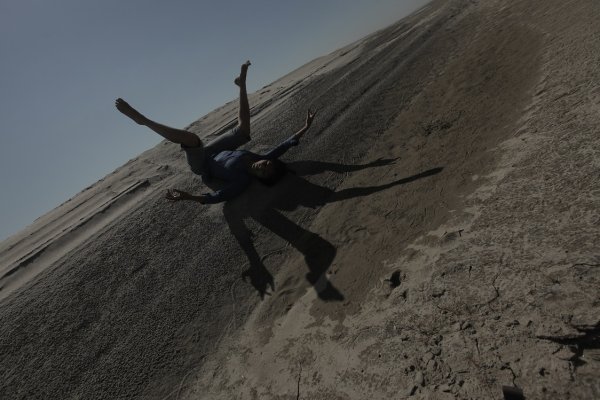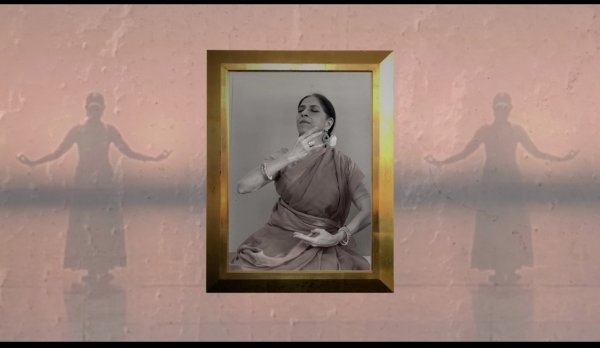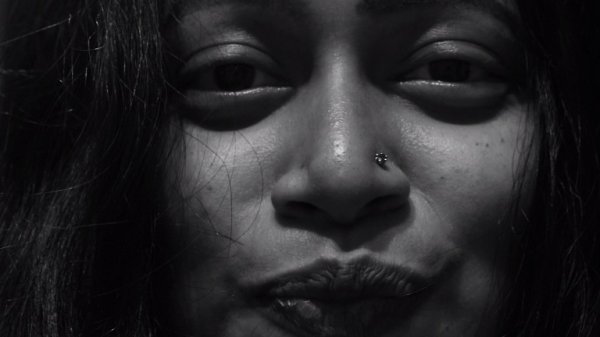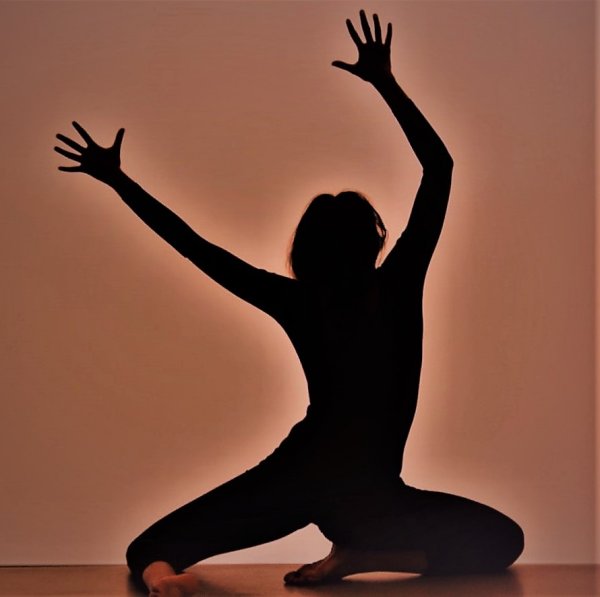
|   |

|   |
 e-mail: ukb7@rediffmail.com Remapping routes in a warped world Photos courtesy: Kalpataru Arts May 18, 2021 Indian classical, folk and contemporary dances - in all their variegated forms - have always been seen live, offered to spectators physically present to enjoy in all their nuances and respond enthusiastically to their context and content, with both stories and gestures, in a 3-D perspective - on temple or court precincts or proscenium stages -- and in real time. If we could call these 'concert dances', there have, of course been occasions when the concert dances have been adjuncts to theatre shows and the celluloid, adding often fresh dimensions to their narrative structure and presentation style. The current global pandemic has systematically proceeded not merely to endanger human life but completely disrupt and fracture the living communications and threatened all forms of human congregation as expression of culture, threaten the very essence of human civilization. The first thing that this catastrophe has done to Indian concert dance is to nearly rule out live performances with live viewers in attendance, and making dance's existence palpably dependent on analog/digital camera, offering 2-D viewing and usually without instant viewer response.  'Nature of Nescience' by Shilpika Bordoloi Chakshu (the Eye), was a 3-day composite program of filmed dances and erudite self-exploration by dancers and scholars in a Webinar on May 7-9, organized by Kri Foundation in collaboration with Kalpataru Arts with global participation, that examined the germane issues. As stated later by Arshiya Sethi, founder of Kri, "What made Chakshu so interesting and important is that it had films made in the past but not seen enough, films made during the pandemic and films made especially for Chakshu. Many generations of dancers, choreographers, promoters and film makers shared their work generously and pro bono. Many were featured in the panel discussion and given a platform to share their ideas, understanding and insights. While respecting the copyright issues, the films were shown only in real time, but the discussions are available on the Face Book pages of Sangita Chatterjee, founder of Kalpataru". Indeed, this was a worthwhile first comprehensive exercise of its kind. As elaborated in the program's concept note earlier, "Chakshu provides the lens through which we see. We consume dance, through the lens of the eye. But sometimes we consume dance, as mediated through another lens. This is the lens of the camera. What does this lens do to dance, where from visual bodies they become tele-visualised? Does it perpetuate dance "in its times" or "dance of the times"? Even as it adds to its longevity and dispersion, how much agency does the lens of the camera assert? Does it make us question more deeply dance's environment and ecosystem? Does it help us interrogate through the lens of dance the world round us? Is screen dance, the product of dance through the perspective of the camera, an independent art by itself, and a standalone future vertical of dance?" As this was a praiseworthy comprehensive vision, this critic would attempt to draw a preliminary and holistic Indian framework concert dance on passive and active camera, and screen dance (defined below) for passive and active camera.  Enframed from 'Within from within' by Aditi Mangaldas Recorded/filmed dance would cover the first genre and indeed, India has preserved at Kalakshetra (Chennai), Darpana (Ahmedabad), Kadamb (Ahmedabad), NCPA (Mumbai) and elsewhere several classic dances choreographed by Rukmini DeviArundale, Mrinalini Sarabhai, Kumudini Lakhia, Balasaraswati, Chandralekha, Birju Maharaj, et al. This effort resembles "Filmed Theatre" archived abroad for classics of West End theatres, Broadway playhouses, Berliner Ensemble, etc., and viewed by public at festivals all over the world (for instance, held in Mumbai in 1982 and witnessed by this critic). Coming to Chakshu, Day 1 saw generic dance films of great beauty, and interrogative spirit which were not viewed frequently. Day 2 brought films made on analog/digital camera during the pandemic. Day 3 carried the same idea forward but also included films made especially for Chakshu by five classical dancers of the younger generation. These dances on passive camera would need some prior understanding between choreographer and the cinematographer, in terms of camera angles for the dancers' face and torso; lens to be used (long shot, medium shot, close-up); zoom lens (changing from long shot to close-up or vice-versa, without losing focus at all); slow motion (to dramatize utplavanas, for instance, with great impact in Narthaki's film series during Navaratri); and other standard aids even from passive camera recordings. Also of great interest was Aditi Mangaldas's idea of freewheeling camera and choreography independent of each other and, later on, doing some 'mix-and-match' of locales and dancers. Narthaki's series of BOXED and ANDAAL'S GARDEN, as curated by the dance aesthete Anita Ratnam, were of great interest in fixing severely the locale parameters in the first series and broadening its scope to include stepping outside, into open Nature, in the second engagement. Concert dance on active camera would mean and include only digital camera for 'live streaming' of real-time performance accompanied by online audience participation and response on the Internet. For example, this was achieved with aplomb by Sapphire Creations in Kolkata under Sudarshan Chakraborty and his associate Paramita Saha for a series of Monthly Editions of contemporary dance early during the pandemic. This involved live transmission to an audience who could raise queries in real-time; included a real-time transmission process with some amount of online editing; and needed a lot of prior understanding of choreography by the broadcaster and of camera technology by the choreographer. One advantage - as was used -- of live content is having a focused audience at the same time and in real time. As a result, content owners can take advantage and actually interact with the audience, or have the audience interact with each other. This can be done through a 'chat' or a 'Q&A' with the video stream. Chats are a great way for viewers to build the excitement amongst each other, such as reacting to an event in the stream or responding to insight other viewers are providing. Q&A can make the live stream even more personal, giving viewers a chance to participate and also make the content more relevant to one and all.  'Jam Upload Download Upload Jam' by Sumedha Bhattacharya This brings one to the last two genres of screen dance for camera where substantially new construction of the dance is attempted: in the third genre for passive camera to bring it closer to cinematography and, more excitingly in the fourth genre, for digital camera in conjunction with other emerging technologies like Artificial Intelligence (AI). For both these genres of dance, this critic would borrow the term 'screen dance' in contrast to 'concert dance', as coined by the dance scholar Douglas Rosenberg (present in Chakshu) and would assume that there would be some social significance of the work and it would contribute to culture. 'Dance for camera' would, in fact, be the overarching framework within which there would be many sub-categories, each of which would need a storyboard; the viewer would seek a narrative structure; and the dancing body would be both subject and object of the form. For helping to create the third genre, one may look at four classic cinematic techniques used for art cinema by the film auteur Satyajit Ray. In his second film of Apu trilogy, The Unvanquished, Apu's father Harihar's death in Banaras is followed instantly by a bunch of parrots flying away noisily with flapping wings; this was 'rapid cutting' technique to symbolise instantly ridding Apu of the rustic life and hurtling him into the hard urban milieu. In Ray's third trilogy film, The World of Apu, 'dissolve' technique ('fade out' followed by 'fade in') signifies beautifully the nascent construction of conjugal privacy. In the opening shot of Charulata, 'deep focus long take' technique is used to depict slow moving camera following the lonely woman's binocular tracking of the passing fašade of life just outside her window. Finally, selection, cutting and piecing together of the dawn's break as a connective whole was the 'montage' technique used by Ray in the opening shot of The Unvanquished to show the morning's halting advent at Banaras's Dashashwamedh Ghat.  'Mirage' by Sangita Chatterjee For the third genre (and later also for the fourth), Rosenberg refers to the re-formulation of the dancer's body aesthetic and, indeed, re-structuring of the entire choreography as transforming dance from corporealisation into re-corporealisation, in that order. Whether we accept the new coinage or not, there is little doubt about the total transformation process that would occur in screen dance for passive camera (and screen dance for the active camera as well). In the Indian context, the third genre has already begun during the pandemic shooting process, as was evident in many of the clippings shown during Chakshu. A solitary instance from Chakshu would be the young Sangita Chatterjee's item Mirage, for which she took the cameraman inside the concrete tunnel for providing different visual perspectives and added the sound in the post-production stage, as explained by her later. In fact, the 'post-production editing' (both 'linear editing' of the simple 'cut and splice' kind and, more complex and far-reaching, "non-linear editing' with computer aid) is the crucial process in the third (and fourth) genres. An instance would be the memorable dance films produced especially for Indian Doordarshan Archives by its founder-director Kamalini Dutt in her time. This indeed is a genre where great innovations are feasible and sky is the only limit for imagining what can be done! For screen dance (of both third and fourth genres), Rosenberg proposes two mediating dimensions borrowed from theatre to enhance their scope and capability. The first is Bertolt Brecht's concept of the "Invisible Fourth Wall" and Rosenberg suggests that camera could play the same role with constant shuffling of space and time for screen dance.The second is Richard Schechner's 'Performance Theory" where efficacy and entertainment have a bonding together so that theatre (here, screen dance) produces the desired effect. Indian viewers would claim some familiarity with Bertolt Brecht with Nandikar producing Brecht's Three Penny Opera (in Bengali version Tin Paisar Pala) under Ajitesh Bandyopadhyay; and Film and Television Associates producing Brecht's Mother Courage under Amal Allana; and NSD Repertory producing Anthony Chekov's The Cherry Orchard under Richard Schechner himself. Rosenberg's fascinatingly novel ideas for the domain of screen dance would provide ample food for thought by screen dance connoisseurs.  'Red Stamp' by Sanjukta Wagh This brings one to the fourth (and final) genre of screen dance for active camera, which would necessarily involve digital camera's interaction with modern technologies like AI, mentioned earlier. In reality, this genre is still in the experimental stage even abroad in several universities and multiple dance bodies where, for instance, some applications of AI in Bharatanatyam pedagogy are under exploration. A rough idea of a few such experiments (such as, 'Dancing with technology - the AI style', 'AI adapted to virtual dance partner' and 'Dancing with AI by Valencia James in Bucharest, 2015') was provided in the last session on 'AI aids Dance' in a 5-day Webinar on 'AI as Aids to Arts' conducted by Mridula Anand and this critic for MAHAGAMI University, Aurangabad, held under Parwati Dutta, Dean of Performing Arts, in March 2020. One would venture to say that even in today's apocalyptic world, dancers and dance cognoscente should look at the filled half of the glass and seize the emerging opportunities of 'Dance via-a-vis Camera' to reach their desired audience. The time is now.  Dr. Utpal K Banerjee is a scholar-commentator on performing arts over last four decades. He has authored 23 books on Indian art and culture, and 10 on Tagore studies. He served IGNCA as National Project Director, was a Tagore Research Scholar and is recipient of Padma Shri. Post your comments Pl provide your name and email id along with your comment. All appropriate comments posted with name and email id in the blog will also be featured in the site. |